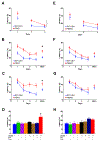Deletion of the creatine transporter gene in neonatal, but not adult, mice leads to cognitive deficits
- PMID: 31209903
- PMCID: PMC6739135
- DOI: 10.1002/jimd.12137
Deletion of the creatine transporter gene in neonatal, but not adult, mice leads to cognitive deficits
Abstract
Creatine (Cr) is a guanidino compound that provides readily available phosphate pools for the regeneration of spent adenosine triphosphate (ATP). The lack of brain Cr causes moderate to severe intellectual disability, language impairment, and epilepsy. The most prevalent cause of Cr deficiency are mutations in the X-linked SLC6A8 (Creatine transporter; CrT) gene, known as CrT deficiency (CTD). One of the most critical areas that need to be addressed is whether Cr is necessary for brain development. To address this concern, the Slc6a8 gene was knocked out in either neonatal (postnatal day (P)5) or adult (P60) mice using a tamoxifen-inducible Cre recombinase driven by the human ubiquitin C (UBC) promoter. Mice were tested in the Morris water maze, novel, object recognition, and conditioned fear 60 days after Slc6a8 deletion. In addition, overnight locomotor activity was analyzed. Mice that had the gene deleted on P5 showed deficits in the Morris water maze and novel object recognition, while there were no deficits in P60 knockout mice. Interestingly, the P5 knockout mice showed hyperactivity during the dark phase; however, when examining control mice, the effect was due to the administration of tamoxifen from P5 to 10. Taken together, the results of this study show that Cr is necessary during periods of brain development involved in spatial and object learning. This study also highlights the continued importance of using proper control groups for behavioral testing.
© 2019 SSIEM.
Conflict of interest statement
Conflict of Interest statements:
Kenea C. Udobi, Nicholas Delcimmuto, Amanda N. Kokenge, Zuhair I. Abdulla, Marla K. Perna, and Matthew R. Skelton declare that they have no conflicts of interest.
Figures




Similar articles
-
Cognitive deficits and increases in creatine precursors in a brain-specific knockout of the creatine transporter gene Slc6a8.Genes Brain Behav. 2018 Jul;17(6):e12461. doi: 10.1111/gbb.12461. Epub 2018 Feb 20. Genes Brain Behav. 2018. PMID: 29384270 Free PMC article.
-
Female mice heterozygous for creatine transporter deficiency show moderate cognitive deficits.J Inherit Metab Dis. 2014 Jan;37(1):63-8. doi: 10.1007/s10545-013-9619-x. Epub 2013 May 29. J Inherit Metab Dis. 2014. PMID: 23716276 Free PMC article.
-
Deletion of the Creatine Transporter (Slc6a8) in Dopaminergic Neurons Leads to Hyperactivity in Mice.J Mol Neurosci. 2020 Jan;70(1):102-111. doi: 10.1007/s12031-019-01405-w. Epub 2019 Sep 13. J Mol Neurosci. 2020. PMID: 31520365 Free PMC article.
-
X-linked creatine transporter deficiency: clinical aspects and pathophysiology.J Inherit Metab Dis. 2014 Sep;37(5):715-33. doi: 10.1007/s10545-014-9713-8. Epub 2014 May 1. J Inherit Metab Dis. 2014. PMID: 24789340 Review.
-
Cerebral creatine deficiencies: a group of treatable intellectual developmental disorders.Semin Neurol. 2014 Jul;34(3):350-6. doi: 10.1055/s-0034-1386772. Epub 2014 Sep 5. Semin Neurol. 2014. PMID: 25192512 Review.
Cited by
-
The Creatine Transporter Unfolded: A Knotty Premise in the Cerebral Creatine Deficiency Syndrome.Front Synaptic Neurosci. 2020 Oct 23;12:588954. doi: 10.3389/fnsyn.2020.588954. eCollection 2020. Front Synaptic Neurosci. 2020. PMID: 33192443 Free PMC article. Review.
-
Maternal Creatine Supplementation Positively Affects Male Rat Hippocampal Synaptic Plasticity in Adult Offspring.Nutrients. 2019 Aug 27;11(9):2014. doi: 10.3390/nu11092014. Nutrients. 2019. PMID: 31461895 Free PMC article.
-
Creatine transporter-deficient rat model shows motor dysfunction, cerebellar alterations, and muscle creatine deficiency without muscle atrophy.J Inherit Metab Dis. 2022 Mar;45(2):278-291. doi: 10.1002/jimd.12470. Epub 2021 Dec 26. J Inherit Metab Dis. 2022. PMID: 34936099 Free PMC article.
-
Rescue of myocytes and locomotion through AAV2/9-2YF intracisternal gene therapy in a rat model of creatine transporter deficiency.Mol Ther Methods Clin Dev. 2024 Apr 23;32(2):101251. doi: 10.1016/j.omtm.2024.101251. eCollection 2024 Jun 13. Mol Ther Methods Clin Dev. 2024. PMID: 38745894 Free PMC article.
-
Epigenetic alterations in creatine transporter deficiency: a new marker for dodecyl creatine ester therapeutic efficacy monitoring.Front Neurosci. 2024 Apr 17;18:1362497. doi: 10.3389/fnins.2024.1362497. eCollection 2024. Front Neurosci. 2024. PMID: 38694899 Free PMC article.
References
-
- Battini R, Alessandri MG, Leuzzi V, et al. (2006) Arginine:glycine amidinotransferase (AGAT) deficiency in a newborn: early treatment can prevent phenotypic expression of the disease. JPediatr 148: 828–830. - PubMed
-
- Brooks SP, Dunnett SB (2009) Tests to assess motor phenotype in mice: a user’s guide. NatRevNeurosci 10: 519–529. - PubMed
-
- Bruun TUJ, Sidky S, Bandeira AO, et al. (2018) Treatment outcome of creatine transporter deficiency: international retrospective cohort study. Metab Brain Dis 33: 875–884. - PubMed
-
- Butler RK, Ehling S, Barbar M, et al. (2017) Distinct neuronal populations in the basolateral and central amygdala are activated with acute pain, conditioned fear, and fear-conditioned analgesia. Neurosci Lett 661: 11–17. - PubMed
-
- Casanova E, Fehsenfeld S, Mantamadiotis T, et al. (2001) A CamKIIalpha iCre BAC allows brain-specific gene inactivation. Genesis 31: 37–42. - PubMed
Publication types
MeSH terms
Substances
Grants and funding
LinkOut - more resources
Full Text Sources
Other Literature Sources
Medical
Molecular Biology Databases
Research Materials
Miscellaneous

